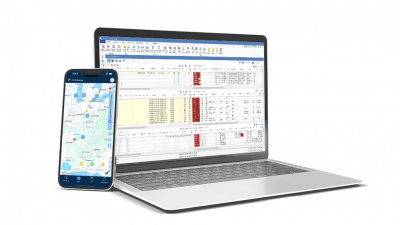Is managing your freight network feeling increasingly complex? You’re not alone. The effective transportation of goods today goes beyond just loading a truck and leaving. It involves a sophisticated orchestration of various tasks, often too complex to handle manually.
Cloud based transportation management systems simplify and automate these intricate tasks. These helpful tools streamline current operations and free up valuable time for strategic planning and improvement.
This article explores the types of transportation management systems available and the top factors to consider when choosing a cloud transportation management system.
What is a Transportation Management System?
Transportation Management Systems (TMS) is an integral component of supply chain management focusing on automating the control and movement of physical goods. These systems are crucial across various sectors, including logistics, manufacturing, retail, and government.
A TMS carries out a range of tasks, such as order management, dispatch and tendering, route scheduling and optimization, carrier management, and more. These tools enhance operational efficiency by offering features like fleet management, real-time tracking, and advanced shipment planning.
The main benefit of a TMS is its ability to provide extensive data visibility, which facilitates the use of business intelligence and analytics tools for insightful decision-making. This capability is vital in managing a complex freight network, transcending simple item transportation. Through automation, TMS solutions simplify time-intensive tasks, enabling a focus on strategic planning and management.
Choosing Between Custom, On-Site, and Cloud Transportation Management
When selecting a TMS, businesses have three main types to consider: custom-built (homegrown), on-premise, and cloud-based. Each offers unique benefits and challenges, and your chosen tool should align with your business needs, resources, and long-term strategy.
Understanding the pros and cons of each type of TMS is crucial in choosing a system that meets your current requirements and supports your future growth. Here are some considerations:
Custom (Homegrown) TMS
A custom TMS is custom-built to meet the unique needs of a business. It’s tailored from scratch and offers bespoke features.
Pros:
- Customization: A homegrown system is tailored to the business’s needs, potentially offering a competitive advantage.
- Cost: Typically involves a one-time development cost.
- Control: Full control over system maintenance and enhancements.
Cons:
- Lack of Best Practices: Custom systems may miss industry best practices.
- Integration Challenges: Difficulties in integrating with other technologies due to unique setups.
- Upgrades and Maintenance: Requires continuous updating and maintenance by an internal IT team.
- Risk of Failure: High risk associated with developing and deploying custom solutions.
On-Premise TMS
A company’s servers and computers contain an on-premise TMS. It offers control and security but requires significant IT resources.
Pros:
- Stability: Off-the-shelf solutions are usually stable, proven, and built on industry best practices.
- Control: High degree of control with everything hosted onsite.
- Security: Enhanced security against online threats.
- Industry-Specific Needs: This may be the only viable option for specific industries.
Cons:
- Time-Intensive Integration: Requires in-house expertise and is time-consuming.
- Location Limitations: Need to be in the office, can’t work from anywhere.
- High Initial Costs: Includes costs for complete license purchases.
- Ongoing Maintenance: Regular maintenance and updates can be costly and inconvenient.
Cloud-Based TMS
This TMS is hosted on the provider’s servers and accessed via the Internet. It offers flexibility, scalability, and lower upfront costs than on-premise systems.
Pros:
- Cost-Efficiency: Lower entry cost due to subscription-based models.
- Scalability: Nearly unlimited storage capabilities.
- Ease of Maintenance: Real-time maintenance and upgrades without system shutdowns.
- Accessibility: Easily accessible via mobile devices, with options for custom integrations.
- Quick Deployment: Faster to deploy compared to other types.
Cons:
- Internet Dependence: Relies on a stable internet connection.
- Data Security: Stored in third-party environments, raising data privacy concerns.
- Vulnerability: Tools without robust security may be at potential risk of external cyber-attacks.
How to Choose a Cloud Transportation Management System in 3 Steps
Many cloud-based transportation management systems are available to streamline operations and enhance efficiency. Choosing the right system for your needs is crucial, so research and compare options before deciding.
Here are three easy steps to select a cloud transportation management tool.
Consider Your Needs and Goals
When selecting a cloud based transportation management system, assessing your current and future needs is essential. Focus on what’s critical for business operations, and don’t pay for features you won’t use. A modular TMS is ideal as it allows functionalities to scale when needed. Additionally, identify the system’s goals, such as maximizing efficiency or reducing costs. Certain TMS solutions may be more effective for specific functions than others.
Evaluate Your Current Technology
Understanding your current technology landscape is crucial. Assess your existing systems’ age, sustainability, and connectivity with other technology platforms like ERP or reporting platforms. Identify your pain points and the functionalities to keep, add, or remove.
Understand the Key Features
Selecting a cloud-based TMS involves understanding its essential features. A robust system should enhance operational efficiency and manage transportation processes effectively. Key features include:
- Load Planning and Optimization: Efficiently plans and optimizes loads considering capacity and cost.
- Carrier Management: Streamlines carrier selection and manages contracts and performance.
- Route Optimization: Considers factors like distance and traffic to choose effective routes.
- Order Tracking: Offers real-time visibility into order status and location.
- Freight Audit and Payment: Automates invoice processing and ensures accurate billing.
- Analytics and Reporting: Provides insights on performance indicators and cost analysis.
- System Integration: Seamlessly integrates with ERP, WMS, and CRM platforms for synchronized data.
- Industry-specific Solutions: Customized functionality for sectors like retail, e-commerce, and manufacturing.
Understanding these key features is crucial in choosing a TMS that meets your immediate needs and scales with your business growth. With the right TMS, you can streamline operations, gain valuable insights, and enhance overall supply chain efficiency.
Choose the Leader in Cloud based Transportation Management With PCS
In the complex world of logistics, selecting the appropriate cloud-based transportation management system is a decision that demands careful consideration. Thoroughly evaluating the offerings and capabilities of each TMS is crucial to ensure the best fit for your needs.
By automating logistics planning, execution, and settlement, PCS Software simplifies logistics management and gives logistics operations a competitive edge. Our platform optimizes costs, routes, and transportation modes, improves visibility in logistics, and manages all transportation activities efficiently.
Discover how our platform can transform your business operations by scheduling a demo today.



